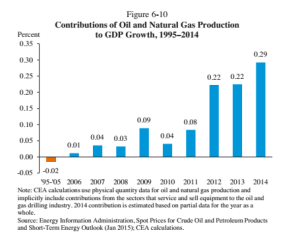America’s natural gas development is driving down the U.S. trade deficit, creating jobs, improving our GDP and cutting greenhouse gas emissions, according to the White House’s “Economic Report of the President” released Thursday. As the President has said in the past – and underscores in the new report – “our 100-year supply of natural gas is a big factor in drawing jobs back to our shores.”
Many of the Obama Administration’s current and former officials have lauded the benefits of responsible shale development. Here’s what they’ve said:
- Dept. of Energy Secretary, Ernest Moniz:“This natural gas revolution is driving economic growth across the country, lowering energy prices and creating jobs.” (Department of Energy, 7/29/14)
- Interior Secretary, Sally Jewell:“[Fracking] has been done for decades and has the potential for developing significant domestic resources and strengthening our economy and will be done for decades to come.” (U-T San Diego, 8/5/13)
- Former Interior Secretary, Ken Salazar: “I would say to everybody that hydraulic fracking is safe.” (Washington Examiner, 9/24/13)
- U.S. EPA Administrator, Gina McCarthy: “Responsible development of natural gas is an important part of our work to curb climate change and support a robust clean energy market at home.” (The Hill, 8/14/13)
Here are the key highlights from the economic report:
- Shale Driving Down U.S. Trade Deficit: One ongoing trade trend that accelerated in late 2014 is the continuing decline in U.S. energy imports. A major part of the decline is due to an expansion in U.S. production of unconventional oil and natural gas. (pg. 67)
- Cutting Green House Gas Emissions: The energy revolution lays the groundwork for reducing domestic greenhouse gas emissions. From 2005 through 2012, the United States cut its total carbon dioxide (CO2) pollution by 12 percent, partly reflecting a domestic shift toward cleaner natural gas. (pgs. 242-243)
- Reversing Energy Production Declines: Recent changes in the energy sector, and their consequences for economic growth and combating climate change, have been remarkable. Breakthroughs in unconventional oil and natural gas extraction technology have reversed the decades-long decline in their production. (pg. 241)
- Natural Gas Cuts CO2 Emissions: Natural gas is already playing a central role in the transition to a clean energy future. Nearly one-half of the CO2 emissions reductions from 2005 through 2013 stem from fuel switching, primarily switching from the use of natural gas, wind, and solar for the purpose of generating electricity. (pg. 280)
- Driving U.S. GDP & Job Growth: The U.S. energy revolution has contributed to economic growth, both in terms of net economic output as measured by GDP and overall employment. It has also contributed to a declining trade deficit as the Nation has recovered from the Great Recession. (pg. 253)

- Cheap Shale Gas Creates “Widespread Benefits”: Since 2006, natural gas prices have fallen well below crude oil prices on an energy-equivalent basis, providing a cheaper source of energy to consumers and businesses in the United States. This price decrease has created widespread benefits and opportunities for the U.S. economy. (pg. 256)
- Residential & Commercial Utility Savings: Low wholesale natural gas prices broadly benefit the U.S. economy in several direct and indirect ways. Residential natural gas prices have followed the decline in wholesale natural gas prices, and the 12-month average price has declined by 18 percent from its 2009 high. Households, which accounted for about one-fifth of U.S. natural gas consumption in 2014, pay lower gas bills and can either spend or save the difference. Commercial and industrial businesses, which accounted for about 40 per? cent of domestic consumption in 2014, also benefit from lower gas prices, which raise business profits. Lower gas prices benefit consumers indirectly to the extent that businesses pass on lower energy prices to consumers in the form of lower product prices. … In other words, electricity consumers—businesses and households—have also benefited from the slower growth of electricity prices caused by lower wholesale natural gas prices. (pg. 257)
- Boosts America’s Global Standing: Lower natural gas prices around the world have a positive geopolitical impact for the United States. Increased U.S. supply builds liquidity in the global natural gas market, and reduces European dependence on the current primary suppliers, Russia and Iran. (pg. 261)
- Robust State & Local Regulations: The regulatory structure for addressing local environmental concerns, especially around land and water use, exists primarily at the State and local level. Research that is actively under way will inform prudent local environmental regulation of hydraulic fracturing. (pg. 283)
- Natural Gas Plays Key Role in Energy Future: Looking further ahead, the current development of natural gas generation infrastructure prepares the Nation for future widespread deployment of wind and solar generation. Wind and solar are non-dispatchable, meaning that electricity generation depends on how strongly the wind is blowing or the sun is shining, in contrast to fossil fuel-fired generators, whose power output can be largely adjusted as needed. Consequently, high market penetration of both wind and solar would benefit from either storage or backup generation capacity. Developing natural gas infrastructure today facilitates its use tomorrow for peak demand and renewable backup generation. (pg. 283)
Shale is a “game changer” for our national economy. “Like” the MSC on Facebook and follow us on Twitter (@MarcellusGas) for more information American-made shale.




